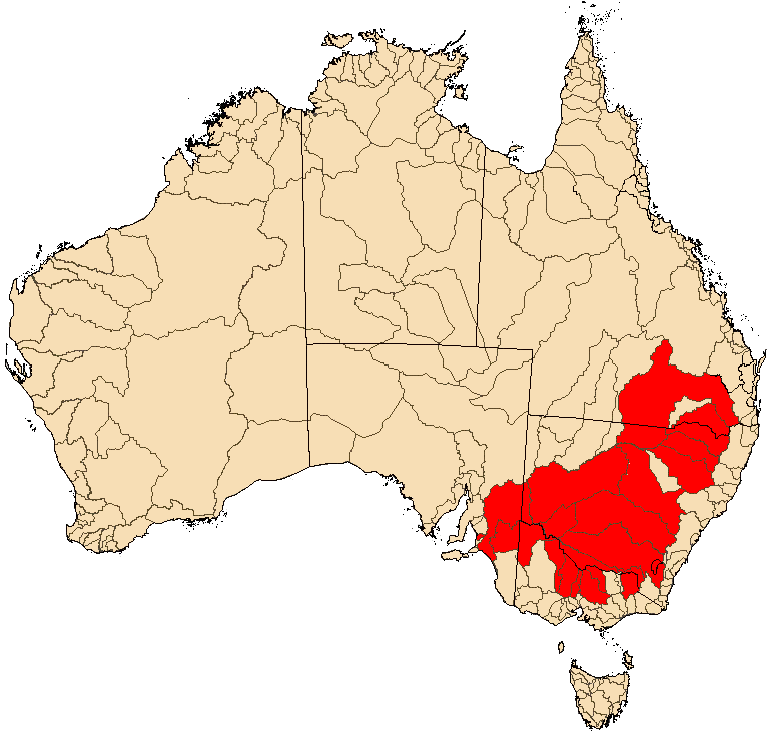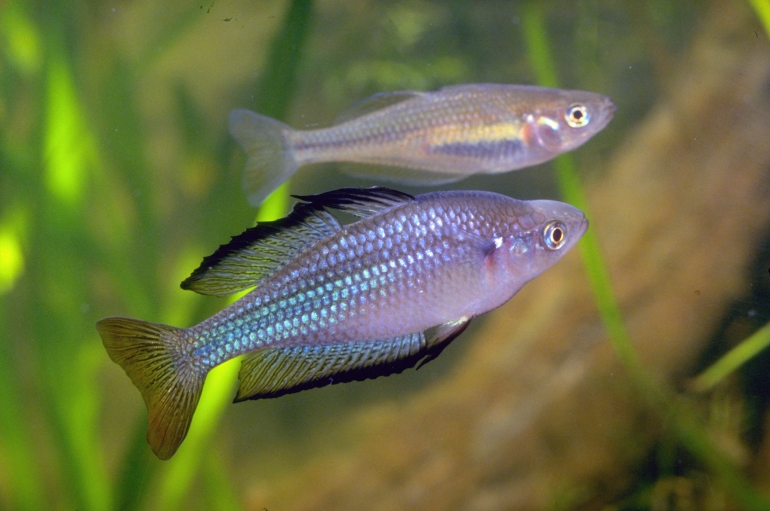|
 GES.jpg) |
Melanotaenia fluviatilis [Murrumbidgee River] - photo© Gunther Schmida |
(Castelnau, 1878)
Murray River Rainbowfish
Species Summary
Melanotaenia fluviatilis were initially collected during the 1870s from the Murrumbidgee River in New South Wales and scientifically described as Aristeus fluviatilis by Castelnau in 1878. Until 1986 this species was considered the same as Melanotaenia duboulayi (both were known as Melanotaenia fluviatilis). Following a review of the rainbowfish family in 1980, they were renamed Melanotaenia splendida fluviatilis. However, a study of its early life-history stages resulted in Melanotaenia splendida fluviatilis being separated into two species, Melanotaenia duboulayi from the eastern coastal drainage systems of northern New South Wales and southern Queensland, and Melanotaenia fluviatilis from the inland Murray-Darling River system. They are not easily distinguished from Melanotaenia duboulayi. Principal variations are body depth, fin counts, and colour pattern. In addition, there are clear differences in egg characteristics and larval development. Southern populations often have a broader head and blunter snout compared to fish from the northern part of the range.
Melanotaenia fluviatilis is a small species with a maximum size of 10 cm, but more commonly less than 8 cm. Males are usually much larger and deeper bodied than females. Mature males can usually be identified from the elongation of posterior rays in the second dorsal and anal fins and are more brightly coloured. Females have smaller rounded dorsal and anal fins. As with most rainbowfishes, the colour is variable depending on location and water conditions. The basic colour is olive, brownish, or slightly turquoise on the back and upper side grading to white on the lower half. A thin reddish stripe is situated between each horizontal scale row, particularly in mature males. There is sometimes a blackish, mid-lateral stripe. Fins are clear to reddish, sometimes with faint spotting. Males may have blackish margins on the dorsal, anal, and anterior margin of the pelvic fins, especially during courtship and spawning. Prior to spawning the male's colour intensifies becoming emerald green, the throat orange and the tailfin red.
 |
Distribution Map |
Distribution & Habitat
Melanotaenia fluviatilis is the most southerly ranging rainbowfish in Australia and is the only species adapted to low winter temperature (normally around 10 to 15° Celsius). However, there is some evidence that numbers are seriously reduced during winter periods, when water temperatures drop below 10° Celsius. Southern populations can survive a few days at 7°C, but are susceptible to bacterial and protozoan infection at these temperatures. Their distribution covers the Murray-Darling River system in Queensland, New South Wales, Victoria, and South Australia. However, specimens collected from the Warrego, Paroo and upper Darling Rivers (and other streams between those tributaries) have been identified as Melanotaenia splendida subsp. tatei based on unpublished gentic data (Unmack, pers. comm.).
Melanotaenia fluviatilis have been found in the middle and lower sections of the Murray, Murrumbidgee and Macquarie Rivers, and in several tributaries of the Darling River. They are considered common and abundant in the Broken River and near Mildura in Victoria, around the Murray-Darling confluence, and in parts of the Goulburn River in Victoria. This species is also present in the middle to upper parts of the Gwydir River near Bingara, the Namoi River around the Peel River, Caroll Gap-Somerton on the Dumaresq River, and the Bogan River near Bogan Gate. It has also recently been recorded in low numbers near Gin Gin on the Macquarie River and Gongologon on the Bogan River. It is moderately common in some areas of its distribution range. However, Victorian and South Australian populations seem to be decreasing in number. This is not surprising; as the Murray River is the most used and abused river system in Australia.
Melanotaenia fluviatilis inhabit rivers, streams, billabongs, drainage ditches, reservoirs, overflows, swamps, and ponds with dense aquatic vegetation. Their natural environment is subjected to seasonal variations with water temperature, pH, and hardness levels varying considerably. They occupy a diverse variety of habitats, occurring in almost every kind of freshwater habitat, from slow-moving streams, swamps, lakes and clear flowing rivers. However, they prefer slow-flowing or still clear water with dense aquatic vegetation, in water temperatures between 18–28° Celsius. They are usually found along grassy banks, or around sub-surface vegetation, submerged logs and branches.
 GS.jpg) |
Melanotaenia fluviatilis [Emu Creek, Condamine River] - photo© Gunther Schmida |
Biology
Not a lot is known about the biology of Melanotaenia fluviatilis in their natural habitat. Most information is mainly based on aquarium observations. Melanotaenia fluviatilis have a well-defined annual reproductive cycle with spawning usually occurring from October to January as water temperatures rise. In captivity spawning will occur throughout the year if temperature is maintained above 20°C. Females produce between 100 and 150 eggs, spawning a number of times daily for several days. Spawning occurs during the early morning or evening just before dark. Each female lays several eggs a day, which are fertilised by the male. Eggs are spherical and colourless and adhere to fine-leaved foliage plants or among the roots of floating vegetation by several long, thin filaments originating at one point on the egg membrane. The water hardened eggs have a diameter of 0.98-1.08 mm and hatch in 5-9 days after fertilisation at water temperatures between 24 and 29°C. The rate of egg development is temperature dependent with time to hatch decreasing with increasing temperature: 9 to 14 days at 20°C; 7 days at 24-25°C; 6 days at 26-27°C; 4-5 days above 28°C. At an incubation temperature below 20°C, many fertile eggs will fail to hatch.
At hatching, larvae 2.5 to 4.2 mm in length have a reduced but still present yolk-sac. The yolk sac is fully absorbed within 3-5 days after hatching. The newly hatched larvae remain in the upper 1-cm water layer within a few hours and begin feeding within 24 hours. The swim bladder inflates within 10 hours of hatching. During the next 12 days there are few changes in larval morphology. The swim bladder gradually elongates to become cylindrical. At 32 days after hatching, the length of the larval is about 13-15 mm and at 72 days 21-25 mm.
Growth rates vary greatly with differences in temperature, feeding rate and densities. Juvenile fish grow quickly and reach maturity in the year following hatching. Sexual maturity occurs at about 4-5 cm for both sexes. Strong sexual dimorphism is present in the species with males typically being larger and brighter in colouration. Melanotaenia fluviatilis is essentially carnivorous, feeding on both aquatic invertebrates associated with its weedy habitat and terrestrial arthropods which may fall onto or alight on the water's surface; however, it is also known to consume algae and fallen plant pollens.
 |
Melanotaenia fluviatilis [Goldburn River, Victoria] - photo© Gunther Schmida |
Literature
Allen G.R. (1980) A Generic Classification of the Rainbowfishes (Family Melanotaeniidae). Records of the Western Australian Museum 8 (3): 449-490.
Castelnau F.L. (1878) On several new Australian (chiefly) fresh-water-fishes. Proceedings of the Linnean Society of New South Wales V. 3 (pt 2): 140-144.
Crowley L.E.L.M. & W. Ivantsoff (1982) Reproduction and early life stages in two species of Australian rainbowfishes, Melanotaenia nigrans (Richardson) and Melanotaenia splendida inornata (Castelnau). Australian Zoologist 21: 85-95.
Crowley L.E.L.M., W. Ivantsoff and G.R. Allen (1986) Taxonomic position of two crimson-spotted rainbowfish, Melanotaenia duboulayi and Melanotaenia fluviatilis (Pisces: Melanotaeniidae), from eastern Australia, with special reference to their early life-history stages. Australian Journal of Marine and Freshwater Research 37(3): 385-98.
Ivantsoff W., L.E.L.M. Crowley, E. Howe and G. Semple (1988) Biology and early development of eight fish species from the Alligator rivers region. Supervising Scientist for the Alligator Rivers Region. Technical Memorandum No.22.
Reid H.P. & D.A. Holdway (1995) Early Development of the Australian Crimson-spotted Rainbowfish, Melanotaenia fluviatilis (Pisces: Melanotaeniidae). Australian Journal of Marine and Freshwater Research 46(2): 475-480.
Adrian R. Tappin
Updated May, 2013



|
|

